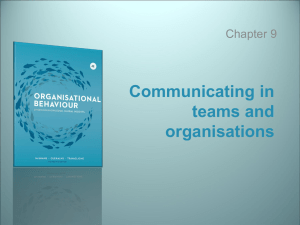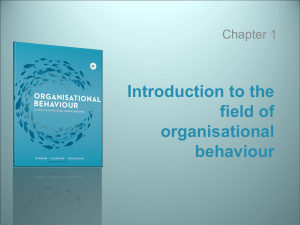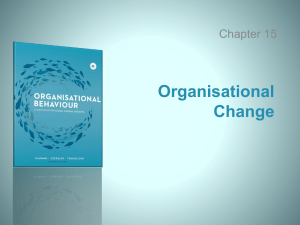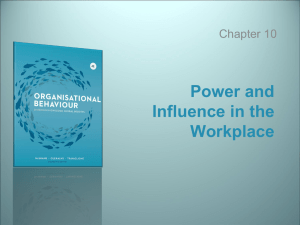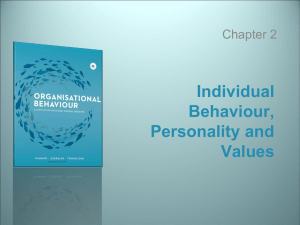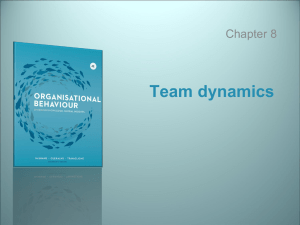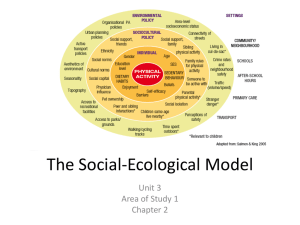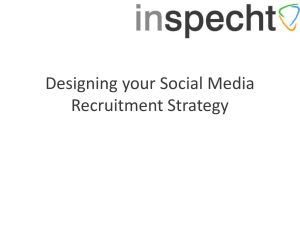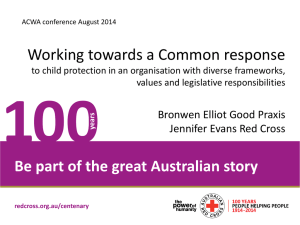PPT_McShane4e_Ch04 - PMS 2123_Organizational Behaviour
advertisement
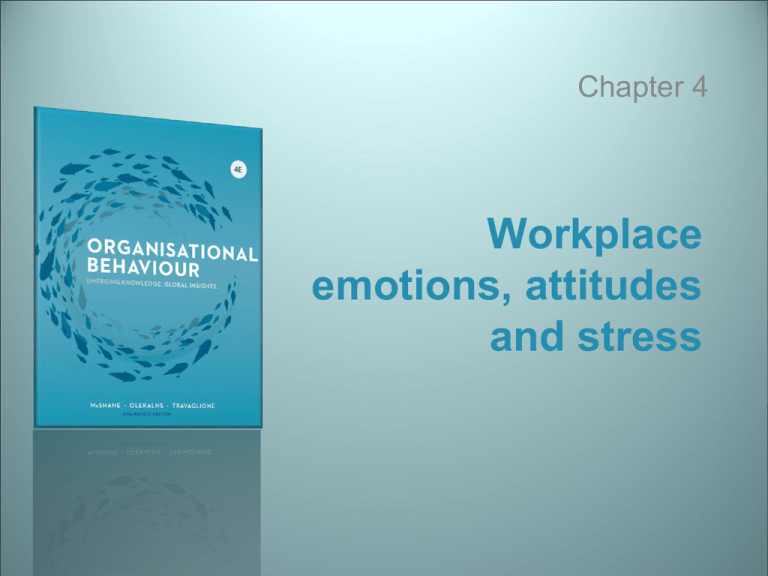
Chapter 4 Workplace emotions, attitudes and stress Learning Objectives 4.1 Explain how emotions and cognition (logical thinking) influence attitudes and behaviour 4.2 Discuss the dynamics of emotional labour and the role of emotional intelligence in the workplace 4.3 Summarise the consequences of job dissatisfaction, as well as strategies to increase organisational (affective) commitment 4.4 Describe the stress experience and review three major stressors 4.5 Identify five ways to manage workplace stress Copyright © 2013 McGraw-Hill Australia Pty Ltd McShane, Olekalns, Travaglione, Organisational Behaviour, 4e 4-2 Positive Attitudes at Rio Tinto Rio Tinto values the health and wellbeing of its staff and the communities in which they work and live. Human resources are the company’s most important asset, and Rio Tinto invests significantly in initiatives that help its staff to achieve and maintain a high quality of life Copyright © 2013 McGraw-Hill Australia Pty Ltd McShane, Olekalns, Travaglione, Organisational Behaviour, 4e 4-3 Emotions Defined • Psychological, behavioural and physiological episodes experienced toward an object, person or event that create a state of readiness • Emotions are experiences. They represent changes in our physiological state, psychological state and behaviour • Emotions put us in a state of readiness Copyright © 2013 McGraw-Hill Australia Pty Ltd McShane, Olekalns, Travaglione, Organisational Behaviour, 4e 4-4 Types of Emotions Copyright © 2013 McGraw-Hill Australia Pty Ltd McShane, Olekalns, Travaglione, Organisational Behaviour, 4e 4-5 Attitudes: From Beliefs to Behaviour Copyright © 2013 McGraw-Hill Australia Pty Ltd McShane, Olekalns, Travaglione, Organisational Behaviour, 4e 4-6 Emotions, Attitudes and Behaviour • Attitudes represent the cluster of beliefs, assessed feelings and behavioural intentions towards a person, object or event (called an attitude object): – Beliefs are established perceptions about the attitude object – Feelings represent positive or negative evaluations of the attitude object – Behavioural intentions represent motivation to engage in a particular behaviour regarding the attitude object Copyright © 2013 McGraw-Hill Australia Pty Ltd McShane, Olekalns, Travaglione, Organisational Behaviour, 4e 4-7 Positive Emotions at ING Direct Australia To attract and keep talented employees, companies are finding creative ways to generate positive emotions in the workplace. Employees at ING have plenty of fun with the annual WOW day (see photo) Copyright © 2013 McGraw-Hill Australia Pty Ltd McShane, Olekalns, Travaglione, Organisational Behaviour, 4e 4-8 Generating Positive Emotions at Work • The emotions– attitudes–behaviour model illustrates that attitudes are shaped by ongoing emotional experiences • Thus, successful companies actively create more positive than negative emotional episodes Copyright © 2013 McGraw-Hill Australia Pty Ltd McShane, Olekalns, Travaglione, Organisational Behaviour, 4e 4-9 Cognitive Dissonance • A state of anxiety that occurs when an individual’s beliefs, feelings and behaviours are inconsistent with one another • Most common when behaviour is: – Known to others – Done voluntarily – Cannot be undone Copyright © 2013 McGraw-Hill Australia Pty Ltd McShane, Olekalns, Travaglione, Organisational Behaviour, 4e 4-10 Emotions and Personality • Emotions are also partly determined by a person’s personality, not just workplace experiences • Some people, especially extroverts, experience positive emotions as a natural trait • Positive and negative emotional traits affect a person’s attendance, turnover and long-term work attitudes Copyright © 2013 McGraw-Hill Australia Pty Ltd McShane, Olekalns, Travaglione, Organisational Behaviour, 4e 4-11 Emotional Labour Defined • Effort, planning and control needed to express organisationally desired emotions during interpersonal transactions • Emotional labour is higher when the job requires: – Frequent and long duration display of emotions – Displaying a variety of emotions – Displaying more intense emotions Copyright © 2013 McGraw-Hill Australia Pty Ltd McShane, Olekalns, Travaglione, Organisational Behaviour, 4e 4-12 Emotional Display Norms Across Cultures • Displaying or hiding emotions varies across cultures: – Minimal emotional expression and monotonic voice in Korea, Japan, Austria – Emotional expression encouraged in Kuwait, Egypt, Spain, Russia Copyright © 2013 McGraw-Hill Australia Pty Ltd McShane, Olekalns, Travaglione, Organisational Behaviour, 4e 4-13 Emotional Dissonance • It is difficult to display expected emotions accurately, and to hide true emotions • Emotional dissonance – Conflict between true and required emotions – Potentially stressful with surface acting – Less stress through deep acting Copyright © 2013 McGraw-Hill Australia Pty Ltd McShane, Olekalns, Travaglione, Organisational Behaviour, 4e 4-14 Emotional Intelligence (EI) • A set of abilities to perceive and express emotion, assimilate emotion in thought, understand and reason with emotion, and regulate emotion in oneself and others Copyright © 2013 McGraw-Hill Australia Pty Ltd McShane, Olekalns, Travaglione, Organisational Behaviour, 4e 4-15 Emotional Intelligence Competencies Copyright © 2013 McGraw-Hill Australia Pty Ltd McShane, Olekalns, Travaglione, Organisational Behaviour, 4e 4-16 Model of Emotional Intelligence Highest Lowest Relationship management Managing other people’s emotions Social awareness Perceiving and understanding the meaning of others’ emotions Self-management Managing our own emotions Self-awareness Perceiving and understanding the meaning of your own emotions Copyright © 2013 McGraw-Hill Australia Pty Ltd McShane, Olekalns, Travaglione, Organisational Behaviour, 4e 4-17 Improving Emotional Intelligence • EI is associated with some personality traits, as well as with parental EI • EI now becomes a selection criteria • Can be learned, especially through coaching • EI increases with age and maturity Copyright © 2013 McGraw-Hill Australia Pty Ltd McShane, Olekalns, Travaglione, Organisational Behaviour, 4e 4-18 Job Satisfaction • A person's evaluation of his or her job and work context • A collection of attitudes about specific facets of the job Copyright © 2013 McGraw-Hill Australia Pty Ltd McShane, Olekalns, Travaglione, Organisational Behaviour, 4e 4-19 EVLN: Responses to Dissatisfaction Exit Voice • Leaving the situation • Quitting, transferring • Changing the situation • Problem solving, complaining Loyalty • Patiently waiting for the situation to improve Neglect • Reducing work effort/quality • Increasing absenteeism Copyright © 2013 McGraw-Hill Australia Pty Ltd McShane, Olekalns, Travaglione, Organisational Behaviour, 4e 4-20 Job Satisfaction and Performance • Happy workers are somewhat more productive workers, however: – General attitude is a poor predictor of specific behaviours – Job performance affects satisfaction only when rewarded – Effect on performance is strongest in complex jobs because of greater employee influence on job performance (e.g. limited in assembly lines) Copyright © 2013 McGraw-Hill Australia Pty Ltd McShane, Olekalns, Travaglione, Organisational Behaviour, 4e 4-21 Employees First, Customers Second at Clydesdale Bank NAB’s Clydesdale Bank treats employees well so that they treat customers well. They listen to and act on employee concerns, spruce up the work environment, introduce career development programs, provide better coaching and give staff more freedom to decide how to serve clients Copyright © 2013 McGraw-Hill Australia Pty Ltd McShane, Olekalns, Travaglione, Organisational Behaviour, 4e 4-22 Job Satisfaction and Customers • Job satisfaction increases customer satisfaction and profitability because: – Job satisfaction affects mood, leading to positive behaviours toward customers – Job satisfaction reduces employee turnover, resulting in more consistent and familiar service Copyright © 2013 McGraw-Hill Australia Pty Ltd McShane, Olekalns, Travaglione, Organisational Behaviour, 4e 4-23 Job Satisfaction and Customers Service profit chain model is a theory explaining how employees’ job satisfaction influences company profitability indirectly through service quality, customer loyalty and related factors Copyright © 2013 McGraw-Hill Australia Pty Ltd McShane, Olekalns, Travaglione, Organisational Behaviour, 4e 4-24 Job Satisfaction and Business Ethics • Job satisfaction is also an ethical issue that influences the organisation’s reputation in the community • Societies now expect companies to provide work environments that are safe and enjoyable Copyright © 2013 McGraw-Hill Australia Pty Ltd McShane, Olekalns, Travaglione, Organisational Behaviour, 4e 4-25 Organisational Commitment • Affective commitment – Emotional attachment to, identification with and involvement in an organisation • Continuance commitment – Calculative attachment: stay because too costly to quit Copyright © 2013 McGraw-Hill Australia Pty Ltd McShane, Olekalns, Travaglione, Organisational Behaviour, 4e 4-26 Consequences of Affective and Continuance Commitment • Organisational (affective) commitment can affect retention, motivation, organisational citizenship and job performance as well as customer satisfaction. However, can lead to conformity and less creativity • Continuance commitment can be dysfunctional and lead to lower performance and less organisational citizenship behaviours Copyright © 2013 McGraw-Hill Australia Pty Ltd McShane, Olekalns, Travaglione, Organisational Behaviour, 4e 4-27 Building (Affective) Commitment Justice/ support Shared values Trust • Apply humanitarian values • Support employee wellbeing • Values congruence • Employees trust org leaders • Job security supports trust Organisational comprehension • Know firm’s past/present/future • Open and rapid communication Employee involvement • Employees feel part of company • Involvement demonstrates trust Copyright © 2013 McGraw-Hill Australia Pty Ltd McShane, Olekalns, Travaglione, Organisational Behaviour, 4e 4-28 What is Stress? • An adaptive response to a situation that is perceived as challenging or threatening to the person’s wellbeing • A physiological and psychological condition that prepares us to adapt to hostile or noxious environmental conditions • Eustress versus distress Copyright © 2013 McGraw-Hill Australia Pty Ltd McShane, Olekalns, Travaglione, Organisational Behaviour, 4e 4-29 General Adaptation Syndrome Copyright © 2013 McGraw-Hill Australia Pty Ltd McShane, Olekalns, Travaglione, Organisational Behaviour, 4e 4-30 Consequences of Distress Physiological Cardiovascular disease, hypertension, headaches Behavioural Work performance, accidents, absenteeism, aggression, poor decisions Psychological Dissatisfaction, moodiness, depression, emotional fatigue, burnout Copyright © 2013 McGraw-Hill Australia Pty Ltd McShane, Olekalns, Travaglione, Organisational Behaviour, 4e 4-31 Job Burnout Process Interpersonal and role-related stressors Emotional exhaustion Cynicism Physiological, psychological and behavioural consequences Reduced personal accomplishment Copyright © 2013 McGraw-Hill Australia Pty Ltd McShane, Olekalns, Travaglione, Organisational Behaviour, 4e 4-32 What are Stressors? • Stressors are the causes of stress—any environmental condition that places a physical or emotional demand on the person • Some common workplace stressors include: – Harassment and incivility – Work overload – Low task control Copyright © 2013 McGraw-Hill Australia Pty Ltd McShane, Olekalns, Travaglione, Organisational Behaviour, 4e 4-33 Psychological Harassment Repeated and hostile or unwanted conduct, verbal comments, actions or gestures that affect an employee’s dignity or psychological or physical integrity and that result in a harmful work environment for the employee Copyright © 2013 McGraw-Hill Australia Pty Ltd McShane, Olekalns, Travaglione, Organisational Behaviour, 4e 4-34 Sexual Harassment • Unwelcome conduct—detrimental effect on work environment or job performance • Quid pro quo – Employment or job performance is conditional on unwanted sexual relations • Hostile work environment – An intimidating, hostile or offensive working environment Copyright © 2013 McGraw-Hill Australia Pty Ltd McShane, Olekalns, Travaglione, Organisational Behaviour, 4e 4-35 Work Overload and Task Control Stressors • Work overload stressor – Working more hours, more intensely than one can cope with – Affected by globalisation, consumerism, ideal worker norm • Task control stressor – Due to lack of control over how and when tasks are performed – Stress increases with responsibility Copyright © 2013 McGraw-Hill Australia Pty Ltd McShane, Olekalns, Travaglione, Organisational Behaviour, 4e 4-36 Individual Differences in Stress • Different threshold levels of resistance to stressor • Use different stress coping strategies • Resilience to stress – Due to personality and coping strategies • Workaholism – Highly involved in work – Inner pressure to work – Low enjoyment of work Copyright © 2013 McGraw-Hill Australia Pty Ltd McShane, Olekalns, Travaglione, Organisational Behaviour, 4e 4-37 Work-Life Balance at Pumpkin Patch • At Pumpkin Patch, the children’s-wear store, employees get to spend time with their children • Pumpkin Patch rewards loyalty and long service, and families with young children are supported with inhouse crèche facilities or childcare subsidies Copyright © 2013 McGraw-Hill Australia Pty Ltd McShane, Olekalns, Travaglione, Organisational Behaviour, 4e 4-38 Managing Work-Related Stress • Remove the stressor – Minimise or remove stressors • Withdraw from the stressor – Vacation, rest breaks • Change stress perceptions – Positive self-concept, humour • Control stress consequences – Healthy lifestyle, fitness, wellness • Receive social support Copyright © 2013 McGraw-Hill Australia Pty Ltd McShane, Olekalns, Travaglione, Organisational Behaviour, 4e 4-39 Summary • Emotions and cognition influence attitudes and behaviour • Emotional labour and emotional intelligence have an important role in the workplace • Managers need to strategically increase job satisfaction and organisational commitment • Stress can be harmful to the employee and the organisation and needs to be managed by both Copyright © 2013 McGraw-Hill Australia Pty Ltd McShane, Olekalns, Travaglione, Organisational Behaviour, 4e 4-40 Chapter 4 Workplace emotions, attitudes and stress
